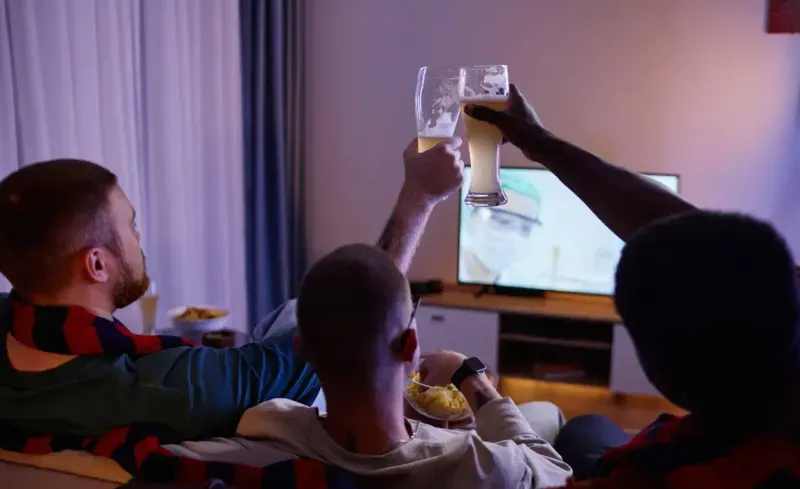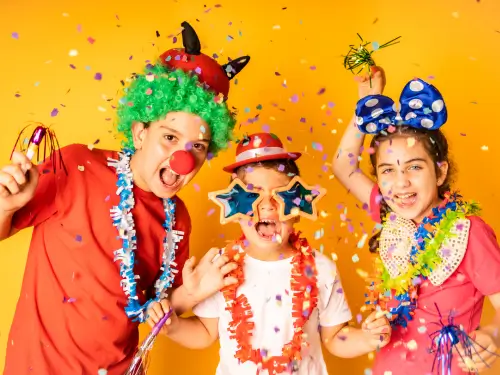Let me save you from my mistakes. My first end of school year party involved 23 first graders, melting ice cream, and a craft activity that took 45 minutes when I had 30 minutes left in the day. Half the class never got to participate, parents looked uncomfortable, and I spent my summer break feeling guilty.
Here's what I wish someone had told me about planning end of year celebrations that actually work.
The Real Timeline (Not the Fantasy One)
Most end of year party ideas floating around Pinterest assume you have unlimited time and budget. You don't. Start with this realistic framework:
Four weeks out: Send your flyer home. Not an elaborate invitation: a simple half-page note that says: "We're celebrating our amazing year together on [date]. I need 3 parent volunteers to help and donations of paper plates, napkins, and cups. Sign-up link below."
Use a free Google Form for the survey. Ask three questions: "Can you volunteer for 90 minutes?", "Any food allergies I should know about?", and "Pizza or ice cream party?" Let families vote. This eliminates the guesswork and gets parents invested early.
Three weeks out: Finalize your activities based on who actually responded. If you got zero parent volunteers, scale back your plans. A movie party with popcorn and one simple activity beats an elaborate celebration that falls apart.
Last week of school: Confirm food orders and prep materials. Print certificates for your awards ceremony the day before—printers always jam when you're rushed.
Activities That Work (Organized by What Actually Happens in Classrooms)
For 1st-2nd Grade: Structure Disguised as Fun
Young elementary students need clear boundaries with built-in excitement. Here's what survives contact with actual six-year-olds:
Memory Book Station (30 minutes) Give each student a pre-stapled 4-page booklet. Page 1: "Draw your favorite memory from the school year." Page 2: "What made you laugh?" Page 3: "Something new you learned." Page 4: "Draw yourself on the last day of school."
The whole class works simultaneously with crayons at their desks. One parent volunteer circulates helping students who need ideas. This keeps everyone engaged and creates a tangible keepsake they'll actually keep.
Freeze Dance with a Twist (15 minutes) Play music and when it stops, call out prompts: "Find someone who has the same favorite color!" or "High-five three friends!" It burns energy, encourages movement, and builds that end-of-year community feeling without being complicated.
The "What We Learned" Beach Ball Game Write questions on an inflated beach ball with permanent marker: "Name a book we read," "What was your favorite science lesson?", "Who made you smile this year?" Toss it around. Whoever catches it answers the question under their right thumb. Takes 10 minutes, costs $3, and gets everyone laughing.
Read Related Article: Watch Party 101: Hosting Tips, Snacks, and Setup Ideas for the Perfect Viewing Night
Learn how to host the perfect watch party with easy setup ideas, fun snacks, and practical tips. From choosing the right theme to creating a cozy viewing space, this guide covers everything you need for a memorable movie or TV night.
Read More
For 3rd-4th Grade: More Independence, Clear Expectations
This age wants to feel grown-up while still enjoying silly fun. Give them choices within boundaries.
Rotating Station Activities (45 minutes total) Set up three stations, students rotate every 15 minutes in groups of 6-8:
Station 1 - Board Game Corner: Have 4-5 cooperative board games (not competitive ones that create winners/losers on your last day together). Parent volunteers explain rules and keep games moving.
Station 2 - Year Slideshow Creation: Students pick their top 3 photos from your classroom photo folder and write one-sentence captions. Compile these into your final slideshow. They're creating content, not just watching passively.
Station 3 - Advice Letters: Students write letters to next year's incoming class. "Dear future 3rd grader, here's what you need to know..." These become incredible bulletin board material in August and give students ownership over their legacy.
Talent Show Reimagined (20 minutes) Forget the traditional talent show where 5 kids perform and 20 watch awkwardly. Do "Minute to Win It" style challenges anyone can join: stack plastic cups into a pyramid in 30 seconds, move cookies from forehead to mouth without hands, keep a beach ball in the air using only breath.
Three students compete at once in each challenge. Everyone gets to participate if they want, nothing requires practice, and the energy stays high.
For Upper Elementary (5th-6th Grade): Treat Them Like the Almost-Middle-Schoolers They Are
Fifth graders don't want "cute." They want meaningful recognition and social time with friends they might not see all summer.
Red Carpet Awards That Matter (25 minutes) Create a literal red carpet from dollar-store plastic tablecloths. Here's the crucial part: every award must reference a specific moment. Not "Best Team Player"—instead, "The Great Compromise Award: Remember when Alex suggested we split into two groups for the science project after everyone disagreed for 20 minutes? That's leadership."
Write these in advance. Make eye contact when presenting. These kids remember generic praise as white noise, but specific recognition changes how they see themselves.
Memory Jar Reveal Starting two weeks before the last day of school, keep a jar at the front of your room. Students anonymously write favorite memories on index cards and drop them in. During your end of year class party, draw them out randomly and have the class guess who wrote each memory.
What makes this powerful: students hear how they impacted classmates they barely knew they'd touched. The quiet kid learns someone appreciated when he shared his markers. The class clown realizes people remember his kindness, not just his jokes.
Photo Booth with Yearbook Stations Set up a simple photo booth using your classroom tablet and a $5 backdrop (or just a decorated wall). While students wait for their turn, they sign each other's yearbooks or memory books at tables. The waiting becomes part of the activity instead of dead time.
Add props: oversized glasses, beach balls, a "Survived 5th Grade!" sign. Upper elementary students pretend they're too cool for this but absolutely light up when posing together.
Read Related Article: Back to School Party Ideas: Ultimate Guide for a Fun and Memorable Celebration
Discover fun and creative back-to-school party ideas with this ultimate guide. From themes and decorations to games, snacks, and kid-friendly activities, get everything you need to plan a memorable celebration for the new school year.
Read More
The Food Situation (Where Things Usually Go Wrong)
Pizza Party Reality Check Order one large pizza for every 4 students. That's 2 slices per child plus 2-3 extra slices for the inevitable "I'm still hungry" requests. Order cheese and pepperoni only—every other topping creates drama with this age group.
Schedule pizza delivery for exactly 45 minutes into your party after the first activity wraps. Students eat while watching your year slideshow. This transitions energy naturally and prevents the post-lunch chaos of feeding everyone first thing.
Ice Cream Party That Won't Melt Use only popsicles instead of scoopable ice cream unless you have a parent volunteer for every 6 students. Real talk: you cannot serve ice cream to 22 third graders by yourself while maintaining any classroom management. The line takes forever, ice cream melts on desks, and someone always cries because their scoop fell.
Popsicles eliminate this entirely. Store them in a cooler, distribute one per student at their desk in under 4 minutes, and you're done. Buy variety packs so students have choices.
The Allergy Minefield Send home that allergy survey three weeks ahead because you need real information, not assumptions. If you have students with dairy allergies, provide juice boxes and fruit cups as alternatives that feel equivalent, not sad substitutes. Nothing ruins an end of year celebration faster than a child sitting alone with nothing while everyone else eats.
Year Slideshow: The Non-Negotiable Element
This is your most valuable 10 minutes. Take photos throughout the school year specifically for this—not posed pictures, but candid moments. Students working together on a math problem. The time it snowed during recess. Someone's birthday celebration. The field trip bus ride.
Add captions with specific dates: "September 15 - First day jitters," "December 3 - Science fair disasters and triumphs," "March 8 - The day we couldn't stop laughing during read-aloud."
Play it twice during your party. Once while students eat, once at the very end. They catch different details each viewing, and it anchors the celebration in genuine shared experiences rather than generic "school is fun" sentiment.
Use free tools like Google Slides with auto-advance timing set to 3 seconds per photo. Add instrumentals from YouTube's royalty-free library—upbeat but not distracting. Total creation time: 30 minutes if you've been collecting photos all year.
Read Related Article: Friendsgiving Party Ideas at Home: Easy Tips for a Memorable Celebration
Plan the perfect Friendsgiving at home with these easy ideas for food, decor, activities, and hosting tips. Create a warm, memorable celebration with simple steps anyone can follow.
Read More
What to Skip Completely
Elaborate crafts - The construction paper chains, friendship bracelets, and painted frames sound adorable. In reality, they eat massive time, create mess at the worst possible moment (end of year when you're packing your classroom), and produce items students forget on their desk. If you want a takeaway, make it paper-based: certificates, memory books, or advice letters.
Outdoor activities with unclear boundaries - Taking 24 students outside for "free play" during the last week of school when routine has dissolved invites chaos. If you're going outside, structure it: relay races with clear teams, organized kickball with assigned positions, or a nature scavenger hunt with specific items listed.
Elaborate decorations - Your students care about doing something fun together, not whether you have a balloon arch. One "Way to End the Year on a High Note!" banner and some streamers achieve the same psychological effect as $50 in Pinterest decorations.
Tips for Planning When You Have Zero Parent Volunteers
Sometimes your flyer generates crickets. You can still create a meaningful end of school year party:
Choose two activities maximum: year slideshow plus one interactive option (board games, memory jar, beach ball questions, or freeze dance). Serve only popsicles or individual packaged snacks you can distribute quickly. Do your awards ceremony throughout the last week of school—2-3 students per day during the last 10 minutes of class—rather than all at once.
This simplified approach often feels more intimate and genuine than over-programmed celebrations.
Making It Actually Memorable (The Part Most Advice Skips)
Your end-of-year celebration succeeds when students leave feeling seen as individuals and connected as a group. That happens through specific recognition, not through generic praise.
When presenting awards, use students' names three times and reference an actual moment: "Maya, remember in October when you noticed Jayden sitting alone at recess and invited him to play? You saw someone who needed a friend and you did something about it. Maya, that's who you are. Maya, that's the person heading into 4th grade."
During your memory jar activity, add your own memories: "I'll remember the day we laughed so hard during that read-aloud that I had to stop reading for five minutes." This vulnerability gives students permission to share their own genuine feelings.
End with a closing circle. Each student completes this sentence: "Something I'll remember about this year is..." No opting out, but they can repeat what someone else said if they're shy. This takes 15 minutes with a class of 24 and creates the sacred closure that makes summer break feel earned rather than abrupt.
The Week After Your Party (What No One Tells You)
Save some engaging activities for the actual last day of school. Your end of year party might happen on a Wednesday, but you still have Thursday and Friday with students who are mentally done. Have backup plans: class game of Pictionary, read-aloud of a funny short book, collaborative art project, or outdoor time with structured activities.
Don't give your party 100% of your remaining energy and leave yourself with nothing for those final days.
Read Related Article: Watch Party 101: Hosting Tips, Snacks, and Setup Ideas for the Perfect Viewing Night
Create the perfect watch party night with easy hosting tips, snack ideas, and setup inspiration. From choosing the right theme to arranging a cozy viewing space, this guide helps you pull off a fun and memorable viewing experience.
Read More
What Actually Matters
I've planned elaborate end of year celebrations with multiple parent volunteers, themed decorations, and complex activity rotations. I've also thrown together simpler parties with just pizza, a slideshow, and heartfelt awards when life got overwhelming.
Students remember both equally well—not because of the activity complexity, but because I was genuinely present, celebrating who they'd become and acknowledging our shared journey. Your end of school year party works when students leave your classroom feeling that their year mattered, their growth was noticed, and their teacher truly liked spending 180 days with them.
Start planning three weeks out, keep activities simple enough to actually execute, feed students properly, and build in specific recognition moments. That's the formula for ending the school year in a fun way that honors everyone's effort without burning out the person planning it.
Your students will remember this celebration during their summer break—not because you had the best Pinterest execution, but because you made them feel valued on their way out the door. That's worth more than perfect decorations or elaborate activities could ever achieve.
Frequently Asked Questions
Here are a few FAQs to guide you through the trickiest parts of planning your celebration.
How do I support students who are moving away during the end-of-year celebration?
A week before the party, privately ask these students whether they prefer a small moment of recognition or none at all. If they’re open to it, include a short “Memory Circle” at the end where a few classmates share something kind they’ll remember. Give the student a class card or slideshow copy as a keepsake. If they prefer privacy, share a handwritten note with them instead and offer contact info (with parent permission) so friendships can continue.
How can I manage behavior when students are mentally checked out for summer?
Set expectations clearly before the party—review rules, practice your freeze signal, and use a large visible timer so students know what’s coming next. Give high-energy students structured roles like station helper or greeter. If the class gets too chaotic, pause the celebration for a brief reset; it quickly reminds students the fun continues only if the group stays on track.
Should families be invited to the celebration?
For younger grades (K–2), student-only celebrations work best to avoid overcrowding and prevent hurt feelings. For grades 3–4, allow families to join for the final 15–20 minutes for awards or the slideshow. Older students (5–6) usually prefer a student-only celebration, but if parents attend, assigning them specific roles helps the event run smoothly. Whatever you choose, communicate it clearly a few weeks in advance so expectations are set.








